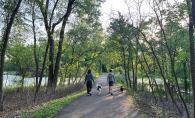Some people consider camping strictly a summer activity. But since most Minnesotans aren’t afraid to get outdoors in the wintertime, camping should be no exception. Edina’s Shepherd of the Hills Lutheran Church Boy Scout Troop #123 knows how it’s done. Several of the troop’s members embark on an annual winter camping experience. This skill-building adventure can be lots of fun, as long as participants adhere to the Boy Scout motto: Be prepared.
For several years local scouts have camped out in winter at William O’Brien State Park. Scoutmaster Dan Leach says the site was selected in part because there are no buildings for scouts to retreat to for drying clothes or warming up. It’s conveniently only 52 miles from Edina.
The scouts handle everything from planning, travel arrangements, equipment preparation and load-out, campout activities and the return trip logistics. According to Bill Burns, whose son is an Eagle Scout, in many ways the preparation, leadership and execution of such a trip is the part of the true scouting experience.
As you might guess, one of the most important skills taught during winter camping events is how to avoid hypothermia. This means focusing on the only temperature that matters—the core temperature, 98.6 degrees. “We’re pushing a lot of hot fluids, high-energy foods that are a combination of simple and complex carbohydrates, as well as salts and fats if [campers] have been involved in strenuous activity such as building a quinzhee,” Leach says.
A quinzhee is a snow shelter made from piling up snow and then hollowing out the pile to create a sort of hut. Building a quinzhee is often a highlight of winter camping but “it’s hard work,” says scout David Woolner. “It took many hours to pile up snow.” Air holes are punched through the snow to prevent carbon dioxide buildup inside, but the snow shelter still holds heat. David says, “That night it was -15 degrees. Inside the quinzhee, it was probably about 30 degrees even with the air holes.”
Other winter survival skills involve melting snow for water, learning what to pack and how to stay dry. Life scout Pete Holmes says he learned that when you fill a Nalgene bottle with warm water to put inside your sleeping bag for added heat make sure it’s sealed tightly.
The scouts feasted on pheasant soup, venison stew, beef stew, salami, cheese, bread, Spam and of course that camping classic, Pop Tarts. The boys also experimented with a “dump cake” recipe that combines pie filling, cake mix and Sprite in a Dutch oven and cooked over a bed of hot coals.
Holmes says he had fun winter camping even though “it’s more challenging than regular camping.” William agrees that spending time outdoors with friends is fun—even in winter.
Winter Camping Packing Tips:
- Base layer of medium or heavyweight long underwear (not cotton)
- Two insulation layers of non-absorbing fabrics like fleece, wool or polyester
- Outer layer including a winter jacket with a hood, hat, boots, gloves
- A sleeping system that achieves a -30 degree temperature rating and some protection from moisture
- Hydration
- Food, cooking supplies and plastic utensils (metal could stick to your tongue)
- Sunscreen (yes, even in winter)
- Lip balm
- Sunglasses
- Headlamp
- Medical supplies
- Camera
- Tarps
- Shovel
- Snowshoes
- Sleds









